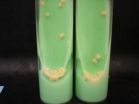(Press-News.org) Researchers at the University of Chicago have shown that after a long stay in the Intensive Care Unit (ICU) only a handful of pathogenic microbe species remain behind in patients' intestines. The team tested these remaining pathogens and discovered that some can become deadly when provoked by conditions that mimic the body's stress response to illness.
The findings, published in mBio®, the online open-access journal of the American Society for Microbiology, may lead to better monitoring and treatment of ICU patients who can develop a life-threatening systemic infection known as sepsis.
"I have watched patients die from sepsis—it isn't their injuries or mechanical problems that are the problem," says John Alverdy, a gastrointestinal surgeon and one of two senior authors on the study.
"Our hypothesis has always been that the gut microflora in these patients are very abnormal, and these could be the culprits that lead to sepsis," he says.
The current study supports this idea. Alverdy and Olga Zaborina, a microbiologist, wanted to know what happens to the gut microbes of ICU patients, who receive repeated courses of multiple antibiotics to ward off infections.
They found that patients with stays longer than a month had only one to four types of microbes in their gut, as measured from fecal samples—compared to about 40 different types found in healthy volunteers.
Four of these patients had gut microbe communities with just two members-- an infectious Candida yeast strain and a pathogenic bacterial strain, such as Enterococcus faecium or Staphylococcus aureus and other bugs associated with hospital-associated infections. Not surprisingly, almost all of the pathogenic bacteria in these patients were antibiotic resistant.
"They've got a lot of bad guys in there, but the presence of bad guys alone doesn't tell you who's going to live or die," says Alverdy. "It's not only which microbes are there, but how they behave when provoked by the harsh and hostile conditions of critical illness."
To check that behavior, the team cultured microbe communities from ICU patients and tested their ability to cause harm in a laboratory model of virulence. The tiny Caenorhabditis elegans worm normally feeds on soil microbes, but when fed pathogenic microbes in the lab, the worms act as a canary-in-the-coalmine indicator of virulence. The more virulent a microbe, the more worms it kills.
Feeding the worms the yeast-plus-bacteria communities did not kill many worms, but when the bacteria were removed, the yeast alone became deadly. In some cases, simply changing the bacterial partner caused virulence. This suggests that even though the two microbes in these communities are both pathogens, they exist in a communal balance in the gut that does not always lead to virulence.
"During host stress, these two microbes suppress the virulence of each other," says Zaborina. "But if you do something to one of them, then that can change their behavior."
For example, the team found that adding an opioid drug to the mix—which mimics stress signals released by sick patients—could also switch behavior from a peaceful coexistence called commensalism to virulence for some microbe pairs. The team could prevent this switch to virulence by feeding the worms a molecule that created high phosphate levels in their gut.
Although the study was too small for statistical significance, there was a correlation between microbe behavior and whether a patient lived or died: two patients who were discharged had microbes that coexisted peacefully, but the three who died of sepsis had at least one sample that displayed pathogenic behavior.
The work suggests that doctors should try to find ways to minimize the excessive use of antibiotics and stabilize the microbes that do remain in ICU patients' guts. This might be achieved by delivering phosphate or reducing the stress signals in the gut. Such efforts could keep microbes calm and non-virulent, leading to better patient outcomes.
INFORMATION:
This research was supported by the U.S. National Institutes of Health and the U.S. Department of Energy.
mBio® is an open access online journal published by the American Society for Microbiology to make microbiology research broadly accessible. The focus of the journal is on rapid publication of cutting-edge research spanning the entire spectrum of microbiology and related fields. It can be found online at http://mbio.asm.org.
The American Society for Microbiology is the largest single life science society, composed of over 39,000 scientists and health professionals. ASM's mission is to advance the microbiological sciences as a vehicle for understanding life processes and to apply and communicate this knowledge for the improvement of health and environmental and economic well-being worldwide.
Critically ill ICU patients lose almost all of their gut microbes and the ones left aren't good
2014-09-23
ELSE PRESS RELEASES FROM THIS DATE:
Video blinds us to the evidence, NYU, Yale study finds
2014-09-23
Where people look when watching video evidence varies wildly and has profound consequences for bias in legal punishment decisions, a team of researchers at New York University and Yale Law School has found. This study raises questions about why people fail to be objective when confronted with video evidence.
In a series of three experiments, participants who viewed videotaped altercations formed biased punishment decisions about a defendant the more they looked at him. Participants punished a defendant more severely if they did not identify with his social group and punished ...
AWHONN recommends reducing overuse of labor induction
2014-09-23
Washington, DC, September 23, 2014 —The Association of Women's Health, Obstetric and Neonatal Nurses (AWHONN) is calling upon healthcare providers and pregnant women to avoid induction of labor at any time during pregnancy unless it is medically necessary.
Approximately one-in-four U.S. births are induced, a number that has more than doubled since 1990. While there are limited data to distinguish how many of these inductions are for medical and non-medical reasons, there is no data to suggest that the significant increase in the induction rate is attributable to a similar ...
New measure provides more data on oxygen levels during sedation
2014-09-23
September 23, 2014 – The "area under the curve of oxygen desaturation" (AUCDesat) may provide a more sophisticated approach to monitoring blood oxygen levels during procedures using sedation, according to a study published in Anesthesia & Analgesia.
The AUCDesat provides information not only whether blood oxygenation has dropped too low—but also on the depth, duration, and rate of episodes of oxygen desaturation. The new study by Paul Niklewski, PhD, of University of Cincinnati and colleagues reports on the development of the AUCDesat as a potentially useful new approach ...
Termites evolved complex bioreactors 30 million years ago
2014-09-23
Achieving complete breakdown of plant biomass for energy conversion in industrialized bioreactors remains a complex challenge, but new research shows that termite fungus farmers solved this problem more than 30 million years ago. The new insight reveals that the great success of termite farmers as plant decomposers is due to division of labor between a fungus breaking down complex plant components and gut bacteria contributing enzymes for final digestion.
Sophisticated Management in Termite Fungus Farms
Fungus-farming termites are dominant plant decomposers in (sub)tropical ...
Speaking of Chemistry: Why we need antibiotics (video)
2014-09-23
WASHINGTON, Sept. 23, 2014 — Antibiotics revolutionized health care in the early 20th century, helping kill bacteria that once killed thousands of people. But bacteria are also constantly outsmarting science, and new strains of antibiotic-resistant bacteria are popping up more frequently. This week's Speaking of Chemistry focuses on the current shortage of new antibiotics and discusses the prospects for new drugs. The episode also answers the question: Why should you finish your pills if you feel better? Check it out at: http://youtu.be/MAoDuSxXIUQ.
Antibiotics are just ...
Brain wave may be used to detect what people have seen, recognize
2014-09-23
Brain activity can be used to tell whether someone recognizes details they encountered in normal, daily life, which may have implications for criminal investigations and use in courtrooms, new research shows.
The findings, published in Psychological Science, a journal of the Association for Psychological Science, suggest that a particular brain wave, known as P300, could serve as a marker that identifies places, objects, or other details that a person has seen and recognizes from everyday life.
Research using EEG recordings of brain activity has shown that the P300 ...
Researchers develop new DNA sequencing method to diagnose tuberculosis
2014-09-23
Researchers working in the UK and The Gambia, have developed a new approach to the diagnosis of tuberculosis (TB) that relies on direct sequencing of DNA extracted from sputum (a technique called metagenomics) to detect and characterize the bacteria that cause TB without the need for time-consuming culture of bacteria in the laboratory.
The research, reported today in the peer-reviewed journal PeerJ, was directed by Professor Mark Pallen, Professor of Microbial Genomics at Warwick Medical School and Dr Martin Antonio, head of the TB diagnostics laboratory at UK Medical ...
Chimpanzees raised as pets or performers suffer long-term effects on their behavior
2014-09-23
Although the immediate welfare consequences of removing infant chimpanzees from their mothers are well documented, little is known about the long-term impacts of this type of early life experience. In a year-long study, scientists from Lincoln Park Zoon observed 60 chimpanzees and concluded that those who were removed from their mothers early in life and raised by humans as pets or performers are likely to show behavioral and social deficiencies as adults.
The multi-institutional research project, published today in the open-access journal PeerJ, was led by Steve Ross, ...
Does the belief in guardian angels make people more cautious?
2014-09-23
Los Angeles, CA (September 23, 2014) While many believe that guardian angels watch over to keep them safe in a dangerous world, a new study finds that those who believe are actually less inclined to take risks despite this believed protection. This study was published today in the open access journal SAGE Open.
Researchers David Etkin, Jelena Ivanova, Susan MacGregor, and Alalia Spektor surveyed 198 individuals and found that of those who believe in guardian angels, 68% said that this belief affects how they take risks.
While some expressed that the belief in guardian ...
A multi-function protein is key to stopping genomic parasites from 'jumping'
2014-09-23
Most organisms, including humans, have parasitic DNA fragments called "jumping genes" that insert themselves into DNA molecules, disrupting genetic instructions in the process. And that phenomenon can result in age-related diseases such as cancer. But researchers at the University of Rochester now report that the "jumping genes" in mice become active as the mice age when a multi-function protein stops keeping them in check in order to take on another role.
In a study published today in Nature Communications, Professor of Biology Vera Gorbunova and Assistant Professor ...

